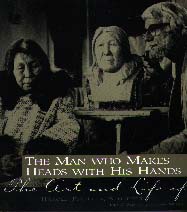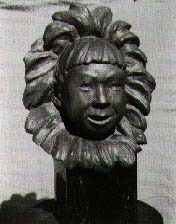

 |
The Man Who Makes Heads With His Hands: The Art and Life of Harold Pfeiffer, Sculptor.
Harold Pfeiffer and John A. Stevens. Subject Headings:
Grades 9 and up / Ages 14 and up.
*** /4
|

excerpt:
Putting my thoughts down about sculpture and sculpting is most difficult. I can't say more than that my large harvest of bronze portraits is an honest concrete story of my first love, sculpting. I have tried to convey to the viewer a true likeness of the subject. There is more to likeness than the simple dimension of facial features which, of course, I respect....The modelling process of sculpting takes time, and a relationship develops which, consciously or not, affects the way the sculptor sees his subject.
 These words by Harold Pfeiffer characterize both the content and the style of The Man Who Makes Heads with his Hands. The book is essentially an anecdotal narrative that tells the life story of Quebec City-born Harold Pfeiffer who, by the time he died in 1997 at the age of 89, was one of Canada's most widely-respected sculptors. As the book makes very clear, however, Pfeiffer's interests ranged far beyond sculpture; he was also an antiquarian, a teacher and collector of traditional Canadian crafts, an ethnographer and, perhaps above all, a "collector of people." The text is peppered with references to conversations Pfeiffer had with a wide range of people over the years (some subjects of his sculptures and some not) from Pierre Trudeau and Chief Dan George to Newfoundland fishermen and villagers from remote areas in the Canadian and Siberian Arctic. Pfeiffer was drawn to older and especially Aboriginal people from all parts of the North and the Canadian West as subjects for his sculpture, and he had a gift for getting them to talk about themselves. In so doing, he was able to preserve both the physical appearances and narratives of people whose stories might otherwise have been lost. Pfeiffer's works are housed in many private and public collections (listed in Appendix III Exhibitions and Collections), the Prince of Wales Northern Heritage Centre in Yellowknife being one of the most notable.
These words by Harold Pfeiffer characterize both the content and the style of The Man Who Makes Heads with his Hands. The book is essentially an anecdotal narrative that tells the life story of Quebec City-born Harold Pfeiffer who, by the time he died in 1997 at the age of 89, was one of Canada's most widely-respected sculptors. As the book makes very clear, however, Pfeiffer's interests ranged far beyond sculpture; he was also an antiquarian, a teacher and collector of traditional Canadian crafts, an ethnographer and, perhaps above all, a "collector of people." The text is peppered with references to conversations Pfeiffer had with a wide range of people over the years (some subjects of his sculptures and some not) from Pierre Trudeau and Chief Dan George to Newfoundland fishermen and villagers from remote areas in the Canadian and Siberian Arctic. Pfeiffer was drawn to older and especially Aboriginal people from all parts of the North and the Canadian West as subjects for his sculpture, and he had a gift for getting them to talk about themselves. In so doing, he was able to preserve both the physical appearances and narratives of people whose stories might otherwise have been lost. Pfeiffer's works are housed in many private and public collections (listed in Appendix III Exhibitions and Collections), the Prince of Wales Northern Heritage Centre in Yellowknife being one of the most notable.
The book is written by author/editor John Stevens, who has a particular interest in Aboriginal history and, as he says, the "stories of unsung heroes," and by the sculptor himself. Both men write separate parts of the text in a similar straightforward, unadorned style. However, Harold Pfeiffer's reminiscences are set apart in blocks surrounded by quotation marks; this feature gives his words the look of live conversation. (Unfortunately, it is not made clear whether these quotations are from older or newer journals or possibly recent taperecordings.) Stevens' contributions to the book provide essential overviews, background information and commentaries on Pfeiffer's narrations.
Harold Pfeiffer's life is presented chronologically in chapters, from his formative years in Quebec, through his years at the National Museum of Man in Ottawa, to his many expeditions and travels in Arctic regions and elsewhere. Interspersed through the text are a large number of well-lit black and white photographs (tinted yellowish-green). One regrets that some of the photos at least are not in full colour; the patina on bronze sculpture is often very beautiful, and the viewer does not get any sense of that here. Some of these photographs, however, do show the subject standing next to the sculpture of him or her, and the viewer can appreciate Pfeiffer's interpretation of the subject's facial structure and character. Almost every double-page spread highlights at least one photograph, and this feature, combined with ample white space around the text, makes for attractive and readable pages.
The Man Who Makes Heads with His Hands will probably be appealing to high school students and adult readers interested in art in general, sculpture, Aboriginal peoples and/or Canadian biography and history. Several sections at the end make this book especially useful for art and history students: the index of proper names; appendices which describe the sculptor's bronze casting process and lists of sculptures, exhibitions and collections; and finally a map of the North where Harold Pfeiffer spend so much of his time.
Recommended.
Ann Stinner is an art education instructor at the University of Manitoba.

To comment on this title or this review, send mail to cm@umanitoba.ca.
Copyright © 1998 the Manitoba Library Association.
Reproduction for personal use is permitted only if this copyright notice
is maintained. Any other reproduction is prohibited without
permission.
Published by
TABLE OF CONTENTS FOR THIS ISSUE - JUNE 5, 1998.
AUTHORS |
TITLES |
MEDIA REVIEWS |
BACK ISSUES |
SEARCH |
ORDER |
CMARCHIVE |
HOME
The Manitoba Library Association
ISSN 1201-9364